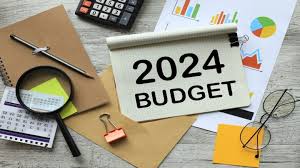Crafting a Resilient Economic Future
In the dynamic landscape of economic planning and foresight, India’s Interim Budget for 2024-2025, meticulously presented by Finance Minister Nirmala Sitharaman, stands out as a beacon of hope and strategic brilliance. As we traverse the complex terrain of fiscal intricacies, this budget not only rises to meet immediate challenges but crafts a trajectory that promises resilience and prosperity for the nation.
*Economic Resilience and Growth:
The projected Real GDP growth of 7.3% in FY 2023-24 is more than a numerical indicator; it symbolizes India’s remarkable economic resilience. Amidst global uncertainties, our nation stands robust, showcasing healthy macro-economic fundamentals and a commendable growth trajectory. The upward revision by the Reserve Bank of India and the International Monetary Fund serves as a testament to the confidence in India’s economic prowess on the world stage.This resilience is not born in isolation but from a robust economic foundation, evident in the careful strategies implemented in past budgets. Finance Minister Nirmala Sitharaman’s previous budgets laid the groundwork for sustainable growth, with a focus on infrastructure, healthcare, and simplifying tax structures. The adaptability to economic challenges has been a hallmark of her tenure, and this budget appears to be a culmination of a strategic vision for a resilient economy.
*Strategic Fiscal Management:”
Finance Minister Sitharaman’s unwavering commitment to fiscal responsibility shines through in the estimated fiscal deficit of 5.1% of GDP for 2024-25. Balancing the imperative for economic stimulus with prudent financial governance reflects a strategic approach. The substantial 11.1% increase in the capital expenditure outlay to Rs 11,11,111 crore underscores a dedicated focus on infrastructure development, a pivotal driver of sustained economic growth.The allocation towards capital expenditure is a clear signal of the government’s intent to invest in long-term economic drivers. Infrastructure development not only stimulates immediate economic activity but also sets the stage for future growth. It is a strategic move that aligns with the government’s vision for sustainable development and economic resilience.
*Inclusive Development Prioritized:
At the heart of this budget lies a profound commitment to uplifting the poor, women, youth, and farmers. By placing the needs and welfare of these crucial segments of society at the forefront, the government signals a transformative agenda that transcends mere economic metrics. This emphasis on holistic development seeks to address societal challenges and foster the well-being of every citizen.The departure from the earlier ‘provisioning up-to-village level’ approach towards a more inclusive and humane strategy is a commendable shift. This holistic approach, encompassing all castes and ensuring development reaches every household and individual, fosters a sense of collective progress. It reflects an understanding that true economic prosperity is intertwined with the well-being of all citizens, making inclusivity a cornerstone of the nation’s development narrative.*Foreign Investment Confidence:*India’s prowess in attracting Foreign Direct Investment (FDI) is illuminated by an impressive inflow of USD 596 billion during 2014-23, marking a golden era. Ongoing negotiations for bilateral investment treaties underscore a commitment to sustaining foreign investment, contributing significantly to India’s global standing.Foreign investment is not just a monetary influx; it is a vote of confidence in India’s economic potential. The negotiation of bilateral investment treaties aligns with the government’s vision of ‘first develop India,’ emphasizing the importance of sustainable foreign investment. It positions India as an attractive destination for global capital, further strengthening its position on the world economic stage.
*Optimistic Vision for the Future:
The Finance Minister’s visionary goal for India to become the world’s third-largest economy by 2027 is not a lofty ideal but an achievable milestone. Projections by international agencies of robust growth rates for 2024-25 propel the narrative of a ‘Viksit Bharat’ (Developed India) by 2047 beyond rhetoric; it becomes a shared national aspiration, a beacon guiding collective efforts.The optimism for the future is not unfounded but grounded in the economic indicators and policy decisions laid out in the budget. The focus on sustainable growth, coupled with a commitment to fiscal responsibility, sets the stage for India to emerge as a global economic powerhouse. It transforms the Finance Minister’s vision from a distant goal to a tangible roadmap with each budgetary allocation contributing to the journey.
*Inclusive Development Approach:
A commendable shift is observed in the government’s departure from the earlier ‘provisioning up-to-village level’ approach towards a more inclusive and humane strategy. This holistic approach, encompassing all castes and ensuring development reaches every household and individual, fosters a sense of collective progress.In conclusion, India’s Interim Budget 2024 not only navigates the intricacies of economic planning but sets the stage for a future characterized by economic resilience, inclusive growth, and global prominence. The strategic fiscal measures, coupled with a steadfast commitment to welfare and development, paint a vivid picture of a nation confidently surging ahead. As citizens, we find ourselves on a promising trajectory, with the government weaving India towards a future defined not merely by economic prosperity but by the comprehensive well-being and empowerment of every individual. This budget is not just a financial plan; it’s a roadmap to a brighter, more inclusive India. The intricate details and strategic nuances embedded in the budgetary allocations underscore the meticulous planning that goes into shaping the economic destiny of the nation. It’s not just about numbers; it’s about weaving a narrative of progress, inclusivity, and prosperity.



